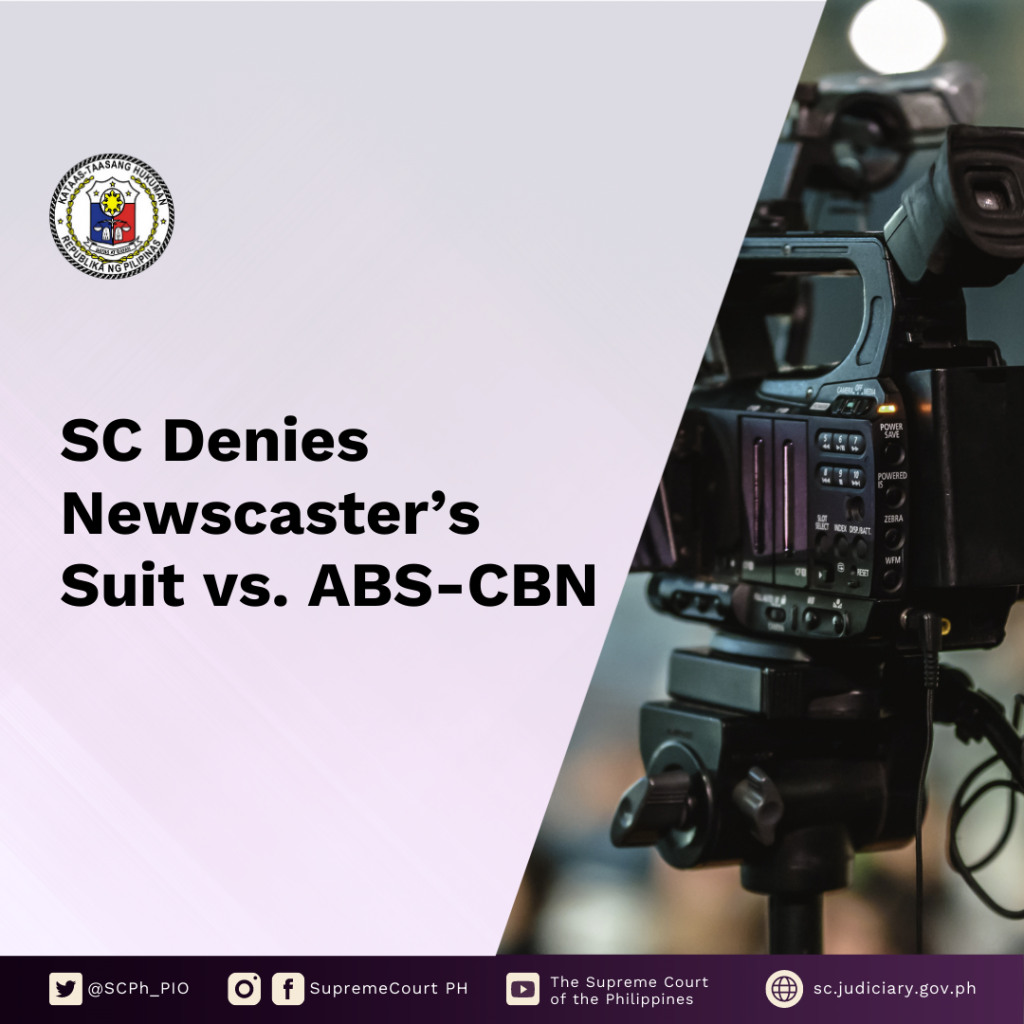The Supreme Court has denied the petition for review filed by newscaster Carmela C. Tiangco (Tiangco) assailing the Decision of the Court of Appeals (CA) regarding her complaint for illegal dismissal and illegal suspension against ABS-CBN Broadcasting Corporation (ABS-CBN) in connection with her appearance in a television commercial.
In a 24-page Decision penned by Justice Rodil V. Zalameda, the Court also affirmed the January 27, 2012 Decision of the CA, which approved the Partial Settlement Agreement dated December 15, 2011 between her and ABS-CBN and rendered judgment declaring that the remaining issues in the case had become moot and academic.
Tiangco, who had been engaged by ABS-CBN as a Talent Newscaster on an exclusive basis since 1986, was placed under a three-month suspension without pay by the latter from her co-anchor positions in TV Patrol and Mel & Jay radio program on January 16, 1996 for allegedly violating a company-issued Memorandum when she appeared in a Tide commercial that aired sometime in December 1995.
The said Memorandum, dated February 8, 1995, directed all its on-air and/or on-camera talents and employees in the Radio and the News and Public Affairs Department to refrain from appearing in commercial advertisements, violation of which would be considered a serious breach of company rules and regulations.
Tiangco filed on March 11, 1996 a complaint against ABS-CBN and its officers for illegal dismissal, illegal suspension, and monetary claims. The Labor Arbiter ruled in her favor and declared illegal her suspension and subsequent constructive dismissal. The National Labor Relations Commission then reversed the Labor Arbiter’s Decision, prompting Tiangco to elevate the Commission’s Decision to the CA on the ground of grave abuse of discretion.
On September 8, 2010, the case was referred to the Philippine Mediation Center, after which the parties executed and signed a Partial Settlement Agreement wherein Tiangco signified that ABS-CBN has paid her in full the amount covering her claims for salaries corresponding to the suspension, 13th month pay, and travel allowance, among others.
The said Agreement was approved by the CA in its assailed January 27, 2012 Decision.
While the Supreme Court agreed with Tiangco’s contention that her claims for separation pay, damages, and attorney’s fees were not fully settled by virtue of the Partial Settlement Agreement between her and ABS- CBN that was approved by the CA, Tiangco was still not entitled to these claims based on the finding that she was not an employee of ABS-CBN but was an independent contractor.
The Court held that “there is no inflexible rule to determine if a person is an employee or an independent contractor; thus, the characterization of the relationship must be based on the particular circumstances of each case.” It emphasized that several factors may be considered by the courts, but what remains the dominant factor in determining whether one is an employee or an independent contractor is the right to control.
The Court disagreed with Tiangco’s claims that she was an employee of ABS-CBN based on the four-fold test in that ABS-CBN specifically selected and hired her for her individual and peculiar talents and skills; that ABS-CBN paid her salaries through a payroll account and withheld compensation income tax; that she was subjected to ABS-CBN’s rules and regulations; and that ABS-CBN controlled the means and method of her performance of her job as newscaster for TV Patrol starting in 1986.
The Court said that Tiangco’s acknowledgment that she was hired by reason of her peculiar talents and skills proved the presence of the elements of an independent contractor. It also said that the payment of Tiangco’s salaries through the company payroll on specified dates with income tax withheld as source was not a conclusive proof of employer-employee relationship, as such an arrangement is often agreed upon only for purposes of convenience.
The Court likewise ruled that nothing on record showed that Tiangco performed other tasks in relation to being an anchor, or that ABS-CBN dictated how she should read the news or perform her other related tasks, if any.
“As a well-known veteran news anchor, petitioner’s manner in delivering the news was distinctly her own,” said the Court. “Her voice, stature, aura, and representation, form part of the unique qualities that impelled ABS-CBN to pick her for the job. Petitioner ‘reading the news’ is not the same as an average person reading the same news. The impact would simply be not the same as there is a premium that goes with petitioner’s stature.”
The Court noted that Tiangco herself admitted she was not under the control of ABS-CBN in her role as a co-host of Mel & Jay when she said in her Petition that “unlike her job as ‘co-host’ of respondent ABS-CBN’s television and radio programs Mel & Jay, how petitioner performed her job as ‘newscaster’ for TV Patrol was 100% under the sole and exclusive control of respondent ABS-CBN.”
The Court, however, ruled that Tiangco failed to establish that ABS- CBN controlled the manner by which she performed her job as TV Patrol news anchor, as it found that she performed the job according to her own manner and method, free from the network’s control.
“Possession of unique skills, expertise, or talent is a persuasive element of an independent contractor. It becomes conclusive if it is established that the worker performed the work according to their own manner and method and free from the principal’s control except to the result,” concluded the Court.
FULL TEXT of G.R. No. 200434 at: https://sc.judiciary.gov.ph/27529/













